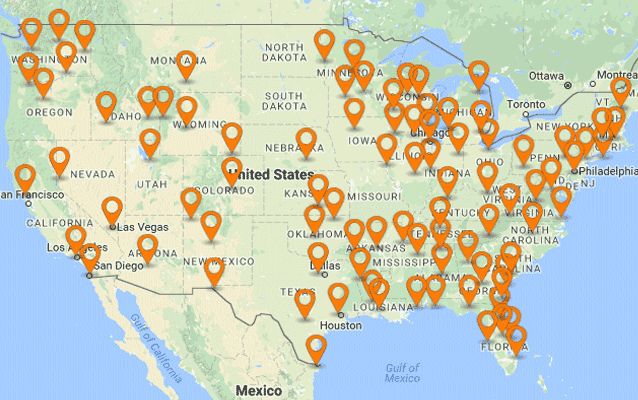Most information has a geographic component when it comes to data and processes. Therefore, businesses have found they miss out on valuable information without a mapping tool as part of a more extensive intelligence suite. For example, teams can provide many insights into a business’s sales performance, territory alignment, customers, and competitors with the right tool. However, achieving these benefits becomes another story despite perceived benefits, requiring teams to understand what they are trying to accomplish and what pain points they are hoping to overcome
In this blog post, we look at defining this type of specialized software and some of the critical use cases where businesses can apply it.
Introduction to Mapping Programs
In definition, this software enables businesses to take data and visualize it in a map format to recognize critical opportunities. Well-designed mapping programs empower users to understand how geography impacts their business and provides a foundation for action. The data is largely similar to what one would find on a spreadsheet and databases. The difference is that mapping programs can display these trends in a way that unlocks this data to improve user understanding and decision-making. Programs may also include options for advanced styling and analysis, including but not limited to heat maps, territory optimization, and more.
The value of these tools becomes evident when users understand the patterns hidden in the numbers and can share these maps on reports, slideshows, or images for a website. When put into practice, this process only takes a few minutes.
Key Use Cases
Businesses from small start-ups to medium-sized businesses to enterprise-level corporations can benefit from mapping software. Therefore, users of this software spread across several use cases in multiple industries, with some of the most common examples listed below:
Map Business Locations
Mapping software enables businesses to plot the locations of their stores, offices or other physical brick and mortar locations. The resulting maps can help customers find a location and compare progress to competitors by identifying areas that a business might want to explore.
Alternatively, businesses might map locations to see which areas have proper coverage, such as retail outlets or operational facilities. Common questions include the number of customers within a distance of a physical store location. Alternatively, tools that look at demographics can display information about who is visiting each of a business’ store locations.
Sales Optimization
Teams often leverage mapping software to improve their sales territory, to see how they can better balance their team’s workload, drive revenue or maximize profitability. By accurately tracking sales team performance, businesses have supported their current customers better and quickly act on new business areas in real-time.
With a color-coded heat map, teams can see customer density within a geographical location and highlight sales territories with overlays. Together, these pieces of information brought to light areas where teams can improve their return on investment.
Planning Out Improved Client Visits
Sales teams often spend time on the road, visiting current and potential clients to conduct face-to-face meetings about a product or service, answering questions, or building up a brand’s image or presence. Although travel is necessary, it is often expensive, especially as client bases grow.
Mapping software can be increasingly useful for these teams to help route sales teams more efficiently. Teams can use these tools to set a polygon or radius and see all the clients they serve in that area. Next, teams can optimize this visitation sequence to ensure valuable personnel travel the fewest miles and raise the lowest reimbursement costs possible. Although savings may appear small, their impact can be quite substantial when implemented on a grand scale.
Route Mapping
Mapping software is a universal tool that helps benefit small and medium-sized companies. This software enables businesses to optimize route planning for their outside sales teams. With many businesses increasing their focus on sustainability, route mapping for efficiency can also be a great way to achieve an advantage over competitors.
Supply Chain Mapping
Supply chains have become increasingly complex with the number of players in the game. Unfortunately, these networks often have weak points in the manufacturing, delivery, and sales map that have the potential to slow down the end-to-end process greatly.
Businesses can calculate the drive time between multiple locations to optimize their logistics or identify opportunities to reduce expenses with a mapping software tool. Teams can import purchasing data with prices, supplier locations, delivery points, and traditional routes. Businesses may also assign tags and apply filters to create quick reports ready for management viewing.
Commercial Real Estate
Another use case is evident in commercial real estate, where site selection is often a daunting task. Many modern mapping software offerings provide a radius tool or integration with Google Places, enabling users to organize their data to identify the best locations for new business properties. Some tools will look at details, including proximity to other businesses or distance between previous locations.
Conducting Market Research
Competitor research is often a crucial component in determining how your business can stay competitive in terms of demographic appeal and market penetration. Therefore, business mapping software demonstrates broad utility beyond one’s operations and clients. Rather, being successful in a competitive industry requires users to identify fellow competitors and how they are responding to market conditions.
Mapping tools can then provide the basis for teams to identify patterns and gaps at an initial glance. Therefore, as competitors take action, your team becomes well-positioned to capitalize on previously missed opportunities and jump on new opportunities as they arise. For example, teams might use a heat map to show where a district, such as a city, country, or state, is being underserved and where the business should focus its resources next.
